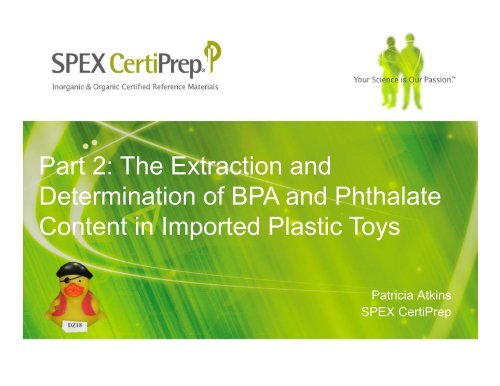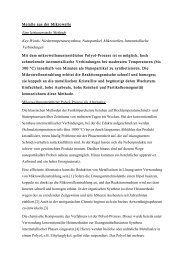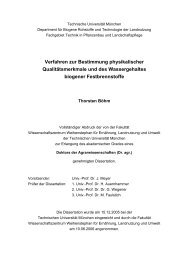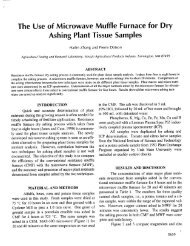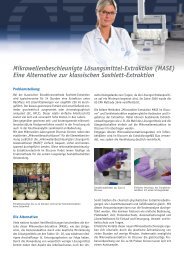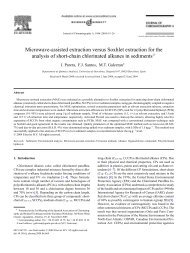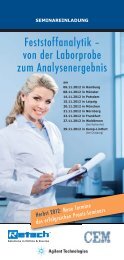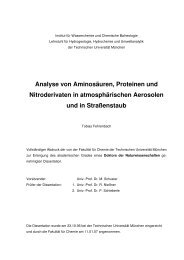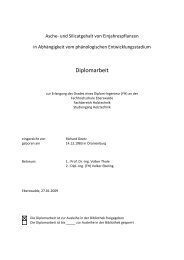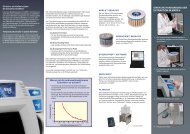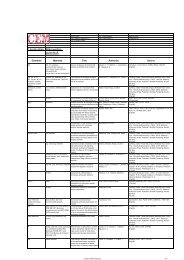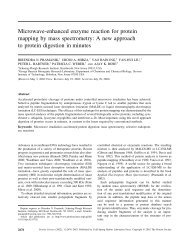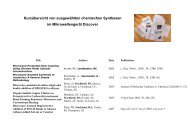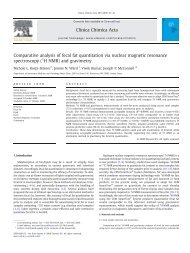Part 2: The Extraction and Determination of BPA and Phthalate ...
Part 2: The Extraction and Determination of BPA and Phthalate ...
Part 2: The Extraction and Determination of BPA and Phthalate ...
Create successful ePaper yourself
Turn your PDF publications into a flip-book with our unique Google optimized e-Paper software.
<strong>Part</strong> 2: <strong>The</strong> <strong>Extraction</strong> <strong>and</strong><br />
<strong>Determination</strong> <strong>of</strong> <strong>BPA</strong> <strong>and</strong> <strong>Phthalate</strong><br />
Content in Imported Plastic Toys<br />
Patricia Atkins<br />
SPEX CertiPrep<br />
© SPEX CertiPrep, Inc. 2012<br />
1
Housekeeping<br />
� Everyone will receive a copy <strong>of</strong> the presentation slides<br />
� <strong>The</strong> webinar is being recorded <strong>and</strong> will be posted to our<br />
YouTube account<br />
� Questions will be answered at the end <strong>of</strong> the presentation<br />
– Type any questions you may have into the question box<br />
<strong>and</strong> we will answer them during the Q&A session<br />
� One lucky attendee will win <strong>The</strong>odore Gray’s <strong>The</strong> Elements<br />
Card Deck!<br />
© SPEX CertiPrep, Inc. 2012
<strong>Phthalate</strong>s Still A Topic <strong>of</strong> Concern<br />
http://www.sciencedaily.com/releases/2012/05/120523102142.htm<br />
© SPEX CertiPrep, Inc. 2012
Common <strong>Phthalate</strong>s<br />
Name Acronym Structural formula CAS No.<br />
Dimethyl phthalate DMP C 6H 4(COOCH 3) 2 131-11-3<br />
Diethyl phthalate DEP C6H4(COOC2H5) 2 84-66-2<br />
Diallyl phthalate DAP C6H4(COOCH2CH=CH2) 2 131-17-9<br />
Di-n-propyl phthalate DPP C6H4[COO(CH2) 2CH3] 2 131-16-8<br />
Di-n-butyl phthalate DBP C6H4[COO(CH2) 3CH3] 2 84-74-2<br />
Diisobutyl phthalate DIBP C6H4[COOCH2CH(CH3) 2] 2 84-69-5<br />
Butyl cyclohexyl phthalate BCP CH3(CH2) 3OOCC6H4COOC6H11 84-64-0<br />
Di-n-pentyl phthalate DNPP C6H4[COO(CH2) 4CH3] 2 131-18-0<br />
Dicyclohexyl phthalate DCP C6H4[COOC6H11] 2 84-61-7<br />
Butyl benzyl phthalate BBP CH3(CH2) 3OOCC6H4COOCH2C6H5 85-68-7<br />
Di-n-hexyl phthalate DNHP C6H4[COO(CH2) 5CH3] 2 84-75-3<br />
Butyl decyl phthalate BDP CH3(CH2) 3OOCC6H4COO(CH2) 9CH3 89-19-0<br />
Di(2-ethylhexyl) phthalate DEHP C 6H 4[COOCH 2CH(C 2H 5)(CH 2) 3CH 3] 2 117-81-7<br />
Di(n-octyl) phthalate DNOP C6H4[COO(CH2) 7CH3] 2 117-84-0<br />
Diisodecyl phthalate DIDP C6H4[COO(CH2)7CH(CH3)2]2 26761-40-0<br />
n-Octyl n-decyl phthalate ODP CH 3(CH 2) 7OOCC 6H 4COO(CH 2) 9CH 3 119-07-3<br />
Diisononyl phthalate DINP C 6H 4[COO(CH 2) 6CH(CH 3) 2] 2 28553-12-0<br />
© SPEX CertiPrep, Inc. 2012
Common <strong>Phthalate</strong>s<br />
Name Acronym Structural formula CAS No.<br />
Di-n-butyl phthalate DBP C 6H 4[COO(CH 2) 3CH 3] 2 84-74-2<br />
Butyl benzyl phthalate BBP CH 3(CH 2) 3OOCC 6H 4COOCH 2C 6H 5 85-68-7<br />
Di(2-ethylhexyl) phthalate DEHP C 6H 4[COOCH 2CH(C 2H 5)(CH 2) 3CH 3] 2 117-81-7<br />
Di(n-octyl) phthalate DNOP C 6H 4[COO(CH 2) 7CH 3] 2 117-84-0<br />
Diisodecyl phthalate DIDP C6H4[COO(CH2)7CH(CH3)2]2 26761-40-0<br />
Diisononyl phthalate DINP C 6H 4[COO(CH 2) 6CH(CH 3) 2] 2 28553-12-0<br />
© SPEX CertiPrep, Inc. 2012
Common <strong>Phthalate</strong>s<br />
Compound Uses<br />
DMP Insect repellent, plastic<br />
DEP Shampoo, scents, soap, lotion, cosmetics, industrial solvent, medications<br />
DBP Adhesives, caulk, cosmetics, industrial solvent, medications<br />
DIBP Adhesives, caulk, cosmetics, industrial solvent<br />
BBP Vinyl flooring, adhesives, sealants, industrial solvent<br />
DCHP Stabilizer in rubber, polymers<br />
DEHP S<strong>of</strong>t plastic, including tubing, toys, home products, food containers, food packaging<br />
DOP S<strong>of</strong>t plastic<br />
DINP S<strong>of</strong>t plastics, replacement for DEHP<br />
<strong>Phthalate</strong>s <strong>and</strong> Cumulative Risk Assessment <strong>The</strong> Task Ahead (2008)<br />
Board on Environmental Studies <strong>and</strong> Toxicology (BEST)<br />
© SPEX CertiPrep, Inc. 2012
Children & Exposure to <strong>Phthalate</strong>s<br />
� Medical Devices: may contain 20-40% DEHP by weight<br />
� Medication: coatings<br />
� Childcare Products<br />
• Ointments<br />
• Lotions<br />
• Shampoos<br />
� Childcare Articles<br />
• Pacifiers<br />
• Bottles<br />
• Plates<br />
• Spoons<br />
� Toys<br />
© SPEX CertiPrep, Inc. 2012
Regulations & Banned <strong>Phthalate</strong>s<br />
US<br />
CPSIA<br />
CPSC-CH-C1001-09.03<br />
EU EC Directive 2005/84/EC<br />
Japan<br />
ST St<strong>and</strong>ard <strong>Part</strong> 3 /<br />
Food Sanitation Law<br />
DEHP DBP BBP DINP DIDP DNOP<br />
0.1%<br />
individual<br />
(All toys &<br />
Childcare)<br />
0.1%<br />
individual<br />
(All toys &<br />
Childcare)<br />
0.1% combined<br />
(All toys)<br />
0.1% combined<br />
(All toys)<br />
0.1%<br />
individual<br />
(All toys &<br />
Childcare)<br />
0.1%<br />
individual<br />
(Oral Contact)<br />
0.1%<br />
individual<br />
(Oral Contact)<br />
0.1% combined<br />
(Toys with Oral Contact)<br />
0.1% combined<br />
(Toys with Oral Contact)<br />
© SPEX CertiPrep, Inc. 2012<br />
0.1%<br />
individual<br />
(Oral Contact)
Infant & Children’s Exposure to<br />
<strong>BPA</strong><br />
� Food & Food Packaging<br />
• Can linings & Containers<br />
• Baby Bottles<br />
• up to 13 µg/kg <strong>of</strong> body wt/day<br />
• Water Bottles<br />
• Liquid Baby Formula<br />
• 0.48 to 11 ng/g<br />
� Paper: Receipts & Labels<br />
� PVC Pipes<br />
� Medical Devices<br />
� Toys<br />
� During Pregnancy<br />
• US study (2009): avg 2.8 ng/mL in 9/10<br />
umbilical cord bloods<br />
© SPEX CertiPrep, Inc. 2012
Regulations<br />
Area Scope <strong>of</strong> <strong>BPA</strong> Ban Requirement<br />
US Various childcare products<br />
No National Ban;<br />
State by State<br />
EU PC baby bottles Banned<br />
Canada<br />
PC baby bottles Banned<br />
<strong>BPA</strong> deemed toxic Action<br />
© SPEX CertiPrep, Inc. 2012
Toy Samples<br />
26 Toys from Discount or Dollar Stores<br />
Items with Oral<br />
Contact<br />
Items with Possible<br />
Oral Contact<br />
© SPEX CertiPrep, Inc. 2012
Sample Preparation: Grinding<br />
Cryogenic grinding allows for a fine analytical powder not possible with<br />
room temperature grinding<br />
© SPEX CertiPrep, Inc. 2012
Sample Identifications<br />
Type<br />
# <strong>of</strong><br />
Samples<br />
LDPE PVC 17 22<br />
LDPE PVC 17 22<br />
HDPE 6<br />
PC 7<br />
PP 2<br />
ABS 1<br />
Silicone 1<br />
Cloth 1<br />
© SPEX CertiPrep, Inc. 2012
Testing Method for <strong>Phthalate</strong>s<br />
CPSC-CH-C1001-09.03<br />
� St<strong>and</strong>ard Operating Procedure for<br />
<strong>Determination</strong> <strong>of</strong> <strong>Phthalate</strong>s<br />
(Children’s Toys & Childcare Articles)<br />
� Measurement <strong>of</strong> 6 Restricted<br />
<strong>Phthalate</strong>s<br />
� Outlines:<br />
• Sample Preparation<br />
• <strong>Extraction</strong><br />
• Analysis<br />
© SPEX CertiPrep, Inc. 2012
Sample <strong>Extraction</strong>: CPSC<br />
© SPEX CertiPrep, Inc. 2012
CPSC Wet <strong>Extraction</strong> Method: PVC<br />
� Intended for PVC not other materials<br />
� For 0.05 g = 15 mL solvent minimum<br />
• PVC Toy samples don’t always<br />
precipitate with 15 mL<br />
• Increased solvent dilutes sample<br />
� At the CPSC limit (0.1% or 1000 µg/g)<br />
• Straight GC injection = 3 ppm<br />
• Diluted per method = 0.7 ppm<br />
o SIM Mode<br />
• Miss other additives<br />
• Misidentify other additives<br />
as phthalates<br />
• Miss low level phthalates<br />
or <strong>BPA</strong><br />
� What is the extraction efficiency <strong>of</strong> the<br />
method?<br />
© SPEX CertiPrep, Inc. 2012
CPSC Wet <strong>Extraction</strong> Method: PVC<br />
� SPEX CertiPrep CRM-PE001:<br />
Polyethylene Matrix<br />
• Recovery for PE material<br />
using PVC wet method =<br />
50%<br />
� New CRM developed for PVC<br />
• Recovery for CPSC Method<br />
= 83 – 94%<br />
• Poor Reproducibility<br />
• GC Contamination<br />
<strong>Phthalate</strong> CPSC Wet Method<br />
%RSD<br />
Dimethyl phthalate 35.09<br />
Diethyl phthalate 36.96<br />
Di-n-butyl phthalate 48.42<br />
Butyl benzyl phthalate 57.72<br />
Bis(2-ethylhexyl)phthalate 58.05<br />
Di-n-octyl phthalate 58.24<br />
Diisononyl phthalate 50.97<br />
Diisodecyl phthalate 60.69<br />
© SPEX CertiPrep, Inc. 2012
Microwave Method Optimization<br />
� Methods Developed by CEM<br />
• HDPE method: Cyclohexane: Acetone (Recovery >95%)<br />
• LDPE method: IPA solvent<br />
• PVC method: Ether<br />
o Did not want to run ether<br />
o Possible dissolution <strong>of</strong> PVC with Acetone<br />
� Goal was not to dissolve polymer<br />
Temp ºC Cyclohexane IPA Acetone Solubility % Recovery<br />
130 50 - 50 Dissolved NA<br />
130 80 - 20 Dissolved NA<br />
100 80 - 20 <strong>Part</strong>itioned/Slightly dissolved 91-101<br />
100 80 20 - Not dissolved 86-98<br />
130 80 20 - Not dissolved 93-100<br />
150 80 20 - Dissolved NA<br />
130 50 50 - Not dissolved 95-105<br />
150 50 50 - Not dissolved 99-102<br />
© SPEX CertiPrep, Inc. 2012
<strong>Extraction</strong> Methods<br />
HDPE<br />
Microwave <strong>Extraction</strong><br />
� 10 mL Cyclohexane:<br />
Acetone (30:70)<br />
� 0.2 g sample<br />
� Ramp to Temperature<br />
• 10 minutes to 140 ºC<br />
• Hold 10 minutes<br />
� Stirring used<br />
PVC<br />
Microwave <strong>Extraction</strong><br />
� 10 mL Cyclohexane: IPA<br />
(50:50)<br />
� 0.2 g sample<br />
� Ramp to Temperature<br />
• 10 minutes to 130 ºC<br />
• Hold 10 minutes<br />
� Stirring used<br />
© SPEX CertiPrep, Inc. 2012
CEM Applications Support<br />
www.cem.com<br />
© SPEX CertiPrep, Inc. 2012
Comparison <strong>of</strong> CPSC Wet Method<br />
vs. Microwave <strong>Extraction</strong> for PVC<br />
THF Wet Method<br />
� Large amounts <strong>of</strong> solvent<br />
� Less concentration on GCMS<br />
system: miss some additives<br />
� Interference <strong>of</strong> polymers with<br />
GCMS operation<br />
� Poor reproducibility<br />
� Time consuming<br />
Microwave Method<br />
� 10 – 15 mL <strong>of</strong> solvent for up to 1 g<br />
<strong>of</strong> sample<br />
� Allows high enough concentration<br />
<strong>of</strong> small phthalates to see on<br />
GCMS<br />
� Dilution possible for higher<br />
concentration phthalates<br />
� Little interference/carryover seen<br />
on GCMS<br />
� Great reproducibility<br />
� Fast, multiple samples processed<br />
at once<br />
© SPEX CertiPrep, Inc. 2012
Comparison <strong>of</strong> CPSC Wet Method<br />
vs. Microwave <strong>Extraction</strong><br />
<strong>Phthalate</strong><br />
Optimized Microwave Method<br />
%RSD<br />
CPSC Wet Method<br />
%RSD<br />
Dimethyl phthalate 2.48 35.09<br />
Diethyl phthalate 0.72 36.96<br />
Di-n-butyl phthalate 0.70 48.42<br />
Butyl benzyl phthalate 2.26 57.72<br />
Bis(2-ethylhexyl)phthalate 1.02 58.05<br />
Di-n-octyl phthalate 1.29 58.24<br />
Diisononyl phthalate 0.36 50.97<br />
Diisodecyl phthalate 0.94 60.69<br />
© SPEX CertiPrep, Inc. 2012
Methods & Materials:<br />
Instrument Conditions<br />
� GC-MS in scan mode with EIC (35-450 m/z)<br />
� CV-5 capillary column (30 m x 0.25 mm x 0.25 µm)<br />
<strong>Phthalate</strong> Abbreviation Ions<br />
Di-n-butyl phthalate DBP 149, 150, 29, 41, 57<br />
Bisphenol A <strong>BPA</strong> 213, 228, 119, 214, 91<br />
Butyl benzyl phthalate BBP 149, 91, 206, 65, 104<br />
Di(2-ethylhexyl) phthalate DEHP 149, 167, 279, 71<br />
Di(n-octyl) phthalate DNOP 149, 279, 43, 57<br />
Dinonyl phthalate DINP 149, 293, 71, 57, 43<br />
Diisodecyl phthalate DIDP 149, 307, 71, 141<br />
© SPEX CertiPrep, Inc. 2012
HDPE Toys<br />
� Plastic Figures<br />
• Police<br />
• Military<br />
• Fireman<br />
� Toy Car <strong>Part</strong>s<br />
• Black Base<br />
• Black Wheel<br />
• Silver parts<br />
© SPEX CertiPrep, Inc. 2012
Results: HDPE Toys<br />
� One restricted<br />
phthalate<br />
• DNOP<br />
• < 0.1% (1000 µg/g)<br />
� No <strong>BPA</strong><br />
� Wheel<br />
• Higher Alkanes<br />
Concentration (µg/g)<br />
140.00<br />
120.00<br />
100.00<br />
80.00<br />
60.00<br />
40.00<br />
20.00<br />
0.00<br />
Di-n-octyl phthalate (µg/g)<br />
Black Car<br />
Military<br />
GI Silver Car<br />
Base <strong>Part</strong><br />
<strong>Part</strong><br />
Police Fireman Black Car<br />
Wheel<br />
Toy Sample<br />
© SPEX CertiPrep, Inc. 2012
PVC Toys<br />
Without Oral Contact Possible Oral Contact<br />
© SPEX CertiPrep, Inc. 2012
PVC Toys: DEHP<br />
DEHP (µg/g)<br />
30000.00<br />
25000.00<br />
20000.00<br />
15000.00<br />
10000.00<br />
5000.00<br />
0.00<br />
US limit 1000 µg/g<br />
Total DEHP in each toy sample<br />
Toy Sample<br />
© SPEX CertiPrep, Inc. 2012
PVC Toys: DINP, DIDP, DNOP<br />
Concentration (µg/g)- log scale<br />
1000000.00<br />
100000.00<br />
10000.00<br />
1000.00<br />
100.00<br />
10.00<br />
1.00<br />
US limit 1000 µg/g<br />
DNOP<br />
DINP<br />
DIDP<br />
Orange Snake Pink Snake Green Snake Donkey Grey Shark Blue Shark Snorkel<br />
Mouthpiece<br />
Toy Sample<br />
© SPEX CertiPrep, Inc. 2012
PVC Toys: Total <strong>Phthalate</strong>s<br />
Total <strong>of</strong> 6 restricted phthalates (µg/g) – log scale<br />
1000000.00<br />
100000.00<br />
10000.00<br />
1000.00<br />
100.00<br />
10.00<br />
1.00<br />
Total Concentration <strong>of</strong> Six Restricted <strong>Phthalate</strong>s in Each Toy Sample<br />
EU/Japan limit 1000 µg/g<br />
US limit 6000 µg/g<br />
Toy Sample<br />
© SPEX CertiPrep, Inc. 2012
Results: <strong>BPA</strong><br />
Conc <strong>of</strong> <strong>BPA</strong> (µg/g)<br />
1400.00<br />
1200.00<br />
1000.00<br />
800.00<br />
600.00<br />
400.00<br />
200.00<br />
0.00<br />
Concentration <strong>of</strong> <strong>BPA</strong> in Selected Toy Samples<br />
Triceratops Duck Doll Head<br />
Toy Sample<br />
© SPEX CertiPrep, Inc. 2012
Results: Other Compounds<br />
100<br />
50<br />
29<br />
41<br />
57<br />
60 69<br />
111<br />
87 102<br />
129<br />
147 157<br />
185<br />
0<br />
20 40 60 80 100 120 140 160 180 200 220 240 260 280 300 320 340 360<br />
(mainlib) Butyl citrate<br />
100<br />
50<br />
29<br />
43<br />
57<br />
129<br />
157<br />
185<br />
61 84<br />
112 139<br />
147<br />
168<br />
213<br />
231<br />
273<br />
329<br />
0<br />
20 40 60 80<br />
(mainlib) Tributyl acetylcitrate<br />
100 120 140 160 180 200 220 240 260 280 300 320 340 360 380<br />
© SPEX CertiPrep, Inc. 2012<br />
400<br />
203 213<br />
O O<br />
259<br />
O<br />
259<br />
HO<br />
O<br />
O<br />
O<br />
O<br />
O<br />
O<br />
O<br />
O<br />
O<br />
O<br />
O
Results: Other Compounds<br />
� Alternative Plasticizers<br />
• Butyl Citrate<br />
• Tributyl Acetyl Citrate<br />
� Measurable levels in 9 <strong>of</strong> 17 toys<br />
• Large % amounts <strong>of</strong> either one or<br />
both = 7 toys<br />
• Highest amounts <strong>of</strong> BC & ATBC=<br />
Lion<br />
© SPEX CertiPrep, Inc. 2012
Conclusions: PVC Toys<br />
� DBP & BBP: CPSC limit <strong>of</strong> 0.1% DEHP<br />
© SPEX CertiPrep, Inc. 2012
Conclusions: PVC Toys<br />
Highest Amounts <strong>of</strong> DEHP<br />
28000 µg/g 25000 µg/g 21000 µg/g 14000 µg/g<br />
Lowest Amounts <strong>of</strong> DEHP<br />
• No phthalates but % <strong>of</strong> alternate plasticizers<br />
• Tributyl Acetyl Citrate<br />
• Butyl Citrate<br />
© SPEX CertiPrep, Inc. 2012
Conclusions: PVC Toys<br />
� Total <strong>Phthalate</strong>s<br />
• Highest total<br />
• Donkey (DIDP & DINP)<br />
• Oral Contact Toys<br />
• Snorkel mouthpiece (> limit)<br />
• Possible Oral Contact Toys<br />
• Duck (DEHP & <strong>BPA</strong>)<br />
� Bisphenol A<br />
• Detected in 3 <strong>of</strong> 17 toys<br />
• Up to 1200 µg/g (Doll Head)<br />
© SPEX CertiPrep, Inc. 2012
Conclusions<br />
� HDPE Toys contained low amounts <strong>of</strong><br />
phthalates<br />
• Only DNOP detected (< limit)<br />
• Higher alkanes seen for one toy part<br />
� PVC toys<br />
• Most <strong>of</strong> the toys contained large amounts<br />
<strong>of</strong> DEHP > all limits<br />
• Some PVC toys also contained DINP,<br />
DIDP <strong>and</strong> DNOP<br />
• <strong>BPA</strong> detected possible oral contact toys:<br />
Duck & Doll Head<br />
• 50% <strong>of</strong> PVC toys contained % quantities<br />
<strong>of</strong> alternate plasticizers<br />
� Further studies planned on the other<br />
polymer toys<br />
© SPEX CertiPrep, Inc. 2012
St<strong>and</strong>ards Used in This Study<br />
<strong>Phthalate</strong> & <strong>BPA</strong> St<strong>and</strong>ards from SPEX CertiPrep:<br />
� S-509: Bisphenol A St<strong>and</strong>ard<br />
� CRM-PE001: PE QC St<strong>and</strong>ard<br />
� CRM-PEBLK: PE Blank<br />
� CRM-PVC001: PVC QC St<strong>and</strong>ard<br />
� CRM-PVCBLK: PVC Blank<br />
� CLPS-1: Internal St<strong>and</strong>ards<br />
© SPEX CertiPrep, Inc. 2012
Thanks<br />
�SPEX CertiPrep Chemists<br />
�CEM Corporation<br />
© SPEX CertiPrep, Inc. 2012
CEM Applications Support<br />
� For Applications Support<br />
– Email: analytical.support@cem.com<br />
– Phone: 800-726-3331<br />
� For Sales Support<br />
– Email: info@cem.com<br />
– Phone: 800-726-3331<br />
© SPEX CertiPrep, Inc. 2012
Questions?<br />
Additional questions can be sent to<br />
CRMSales@spex.com<br />
© SPEX CertiPrep, Inc. 2012
New Products<br />
� Full line <strong>of</strong> 1 ppm ICP-MS<br />
Single Element St<strong>and</strong>ards<br />
Visit www.spexcertiprep.com for<br />
more information<br />
� Trace Metals in Natural Wine<br />
Matrix St<strong>and</strong>ards<br />
– Red: TM-WINE-R1A<br />
– White: TM-WINE-W1A<br />
© SPEX CertiPrep, Inc. 2012
Free Drawing!<br />
<strong>The</strong> Photographic<br />
Card Deck <strong>of</strong> the<br />
Periodic Table<br />
By <strong>The</strong>odore Gray<br />
© SPEX CertiPrep, Inc. 2012
Thank You!<br />
Contact Us!<br />
Pat Atkins<br />
Matt Snyder<br />
CRMSales@spex.com<br />
© SPEX CertiPrep, Inc. 2012


